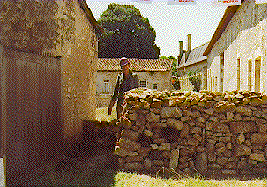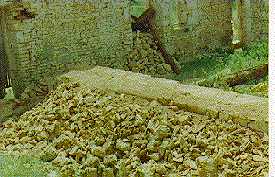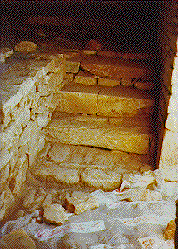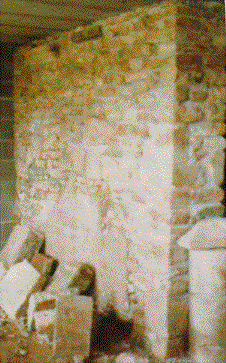

|
||||
| INTRODUCTION | LESSON 1 | LESSON 2 | LESSON 3 | LESSON 4 |
I personally took down most of these walls as I wanted to separate the burned from the still good stones. I removed the soil while lifting out each stone. I then threw down the stones on soft ground in order not to damage them by the shocks. Doing this I learned climbing up and down the leather! It was essential to collect as many of the still usable stones as possible and collect a sufficient amount of material to do the restoration work. I have made negative experiences trying to get stones from neighbors. If they take down an old building they have to pay for the removal of the material and yet if you ask them to let you collect stones by helping them take down the old walls they ask for an outrageous and unacceptable price!
I cleaned the stones from the soil while lifting them off the walls and sorted them as much as possible according to shapes: plates, cubes, wedges, small, medium large blocks and worked edge stones. I mostly stored the stones in dry places or made sure that the top layers protected the rest of the pile. A large quantity of the stones are stored under roof as shown on the left picture. This allows ready access to all possible shapes when building a wall. The remainder of the reserve was stored in piles. Making up the piles gave me an opportunity to practice the building of true dry walls. The picture on the right shows my first dry wall and you can notice that I gained experience reaching the upper layers. This deposit wall is about 50 cm deep which is the minimum depth for a dry wall to reach a height of 2 meters.


About 5 tons of stones are stored in two piles which I arranged as a lock to the entry of the old farm. This to prevent burglars from driving in with their lorries. We had a burglary in January 2000 - they did not find much as there are no valuables in the castle and most of the furniture are copies made in the 20th century. These dry wall piles were made very rapidly by just piling in the stones for a good fit of every stone. The piles are reinforced with oak beams and have a depth of up to 2 meters on the ground. The idea was to deposit such a quantity of material as to make it impossible to pass with a vehicle even if the piles would be torn down.



Even the burned stones were not put to waste. They were used to build up the scene in the festival hall. A 5 times 9 meter stable located on the eastern end of the burned building was used for this. Its inner wall which was very badly burned was torn down to a height of 80 cm. At this level there was a small ridge for feeding the animals and this ridge was used to define the edge of the scene. This approach permitted to safeguard a maximum of the existing structure by reusing it as structural elements for the scene. Interestingly this stable was at a higher level than the remaining building at the existing stairs of two steps were completed to access the scene.
The side wall of the scene, defining the stairs had to be completed and this gave me the opportunity to build my first dry wall. It was roughly bound with lime by squeezing in lime mixture with the gloves. The middle picture below shows the wall before sealing it with lime. Please not the very narrow interstices and the almost complete absence of corrective wedges. Building such a wall takes a great deal of patience and the piece shown in the picture was built up in about 12 hours of hard work. This is an excellent exercise however to learn to know the shapes of stones. I made the experience that increasingly I developed a seventh sense for picking up just the right stone from a pile - often even wondering why I picked a particular stone which did not seem to fit at a first sight! This is the mysterious and fascinating aspect of working with old stones.






The following picture shows a wall built by a local mason. He is one of the best I have learned to know in the area and yet when you look at the wall you will find that the interstices are far larger than on the historic walls. This is the reason why I started to build all visible dry walls myself. You just can not expect today's masons have the patience to build a true dry wall
